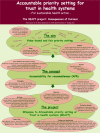The accountability for reasonableness approach to guide priority setting in health systems within limited resources--findings from action research at district level in Kenya, Tanzania, and Zambia
- PMID: 25142148
- PMCID: PMC4237792
- DOI: 10.1186/1478-4505-12-49
The accountability for reasonableness approach to guide priority setting in health systems within limited resources--findings from action research at district level in Kenya, Tanzania, and Zambia
Abstract
Background: Priority-setting decisions are based on an important, but not sufficient set of values and thus lead to disagreement on priorities. Accountability for Reasonableness (AFR) is an ethics-based approach to a legitimate and fair priority-setting process that builds upon four conditions: relevance, publicity, appeals, and enforcement, which facilitate agreement on priority-setting decisions and gain support for their implementation. This paper focuses on the assessment of AFR within the project REsponse to ACcountable priority setting for Trust in health systems (REACT).
Methods: This intervention study applied an action research methodology to assess implementation of AFR in one district in Kenya, Tanzania, and Zambia, respectively. The assessments focused on selected disease, program, and managerial areas. An implementing action research team of core health team members and supporting researchers was formed to implement, and continually assess and improve the application of the four conditions. Researchers evaluated the intervention using qualitative and quantitative data collection and analysis methods.
Results: The values underlying the AFR approach were in all three districts well-aligned with general values expressed by both service providers and community representatives. There was some variation in the interpretations and actual use of the AFR in the decision-making processes in the three districts, and its effect ranged from an increase in awareness of the importance of fairness to a broadened engagement of health team members and other stakeholders in priority setting and other decision-making processes.
Conclusions: District stakeholders were able to take greater charge of closing the gap between nationally set planning and the local realities and demands of the served communities within the limited resources at hand. This study thus indicates that the operationalization of the four broadly defined and linked conditions is both possible and seems to be responding to an actual demand. This provides arguments for the continued application and further assessment of the potential of AFR in supporting priority-setting and other decision-making processes in health systems to achieve better agreed and more sustainable health improvements linked to a mutual democratic learning with potential wider implications.
Figures
Similar articles
-
Fairness and legitimacy of decisions during delivery of malaria services and ITN interventions in Zambia.Malar J. 2010 Nov 1;9:309. doi: 10.1186/1475-2875-9-309. Malar J. 2010. PMID: 21040552 Free PMC article.
-
Increased fairness in priority setting processes within the health sector: the case of Kapiri-Mposhi District, Zambia.BMC Health Serv Res. 2014 Feb 18;14:75. doi: 10.1186/1472-6963-14-75. BMC Health Serv Res. 2014. PMID: 24548767 Free PMC article.
-
Involving decision-makers in the research process: Challenges of implementing the accountability for reasonableness approach to priority setting at the district level in Tanzania.Glob Public Health. 2014;9(7):760-72. doi: 10.1080/17441692.2014.922208. Epub 2014 Jun 12. Glob Public Health. 2014. PMID: 24921238
-
Strengthening fairness, transparency and accountability in health care priority setting at district level in Tanzania.Glob Health Action. 2011;4. doi: 10.3402/gha.v4i0.7829. Epub 2011 Nov 7. Glob Health Action. 2011. PMID: 22072991 Free PMC article. Review.
-
A systems perspective on the importance of global health strategy developments for accomplishing today's Sustainable Development Goals.Health Policy Plan. 2019 Nov 1;34(9):635-645. doi: 10.1093/heapol/czz042. Health Policy Plan. 2019. PMID: 31363736 Free PMC article. Review.
Cited by
-
Necessity under construction - societal weighing rationality in the appraisal of health care technologies.Health Econ Policy Law. 2021 Oct;16(4):457-472. doi: 10.1017/S1744133120000341. Epub 2020 Sep 21. Health Econ Policy Law. 2021. PMID: 32955010 Free PMC article.
-
Accountability for Reasonableness as a Framework for the Promotion of Fair and Equitable Research.Hastings Cent Rep. 2024 Dec;54 Suppl 2(Suppl 2):S66-S72. doi: 10.1002/hast.4931. Hastings Cent Rep. 2024. PMID: 39707939 Free PMC article.
-
Health research priority setting in Zambia: a stock taking of approaches conducted from 1998 to 2015.Health Res Policy Syst. 2016 Sep 23;14(1):72. doi: 10.1186/s12961-016-0142-z. Health Res Policy Syst. 2016. PMID: 27663308 Free PMC article.
-
Procedural fairness and the resilience of health financing reforms in Ukraine.Health Policy Plan. 2023 Nov 14;38(Supplement_1):i59-i72. doi: 10.1093/heapol/czad062. Health Policy Plan. 2023. PMID: 37963081 Free PMC article.
-
Ethical Dilemmas in Protecting Susceptible Subpopulations From Environmental Health Risks: Liberty, Utility, Fairness, and Accountability for Reasonableness.Am J Bioeth. 2018 Mar;18(3):29-41. doi: 10.1080/15265161.2017.1418922. Am J Bioeth. 2018. PMID: 29466133 Free PMC article.
References
-
- Martin D, Singer PA. A strategy to improve priority setting in health care institutions. Health Care Anal. 2000;11(1):59–68. - PubMed
-
- Murray CJL, Lopez A. In: The Global Burden of Disease: A Comprehensive Assessment of Mortality and Disability from Diseases, Injuries, and Risk Factors in 1990 and Projected to 2020. Murray CJL, Lopez AD, editor. Cambridge, MA: Harvard University Press; 1996. Quantifying the burden of disease and injury attributable to ten major risk factors.
-
- Hoedemaekkers R, Dekkers W. Justice and solidarity in priority setting in health care. Health Care Anal. 2003;11(4):325–343. - PubMed
Publication types
MeSH terms
LinkOut - more resources
Full Text Sources
Other Literature Sources
Miscellaneous



